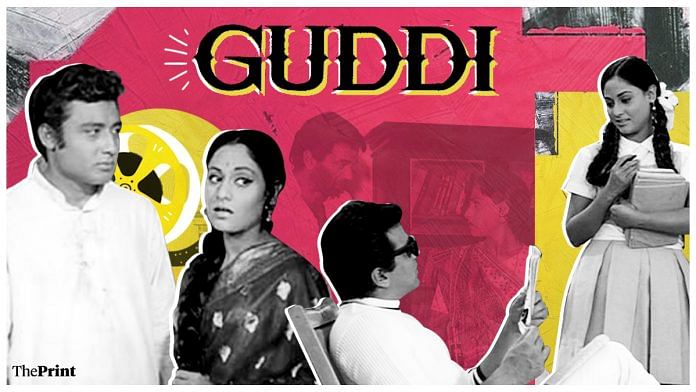New Delhi: The year 1971 was a glorious year for Indian cinema — it was the year classics such as Anand, Kati Patang and Mera Gaon, Mera Desh came out. It was also the year Guddi was released, which marked the debut of Jaya Bachchan.
Co-written by Gulzar and Hrishikesh Mukherjee, who also the director, Guddi was the film that made Jaya Bachchan — then still Jaya Bhaduri — a household name.
In the week that marks the film’s 50th anniversary (it was released on 24 September), ThePrint revisits the coming-of-age story that redefined the concept of a Hindi film heroine in the ’70s.
One of India’s first ‘fan films’, Guddi is about a school girl, played by Jaya. The actor’s spontaneity, vivacious smile, and girl-next-door persona was a breath of fresh air amid the carefully put-together style icons of her time. If Zeenat Aman held up one end of the spectrum, Hema Malini was at the other. Jaya was the tomboy.
With ’70s India changing quickly, so was mainstream cinema. Guddi marked a turn towards realistic cinema within the mainstream format. Through it, Jaya symbolised the young, modern woman who wanted to straddle many worlds, who was willing to break from tradition, be influenced by the winds of change and yet stay grounded.
Also read: ‘Khushboo’ — how Gulzar captured a strong woman who loves but won’t be a pushover
The Dharmendra fan
Jaya’s Guddi is a teenager who loves going to the movies, has no hang-ups about bunking school to go and meet a film actor a day before her exam, and is indulged by her close-knit and open-minded family. Despite the wild streak, she also is equally comfortable draping a saree to keep her bhabhi (sister-in-law) happy.
Jaya crushes on Dharmendra, who plays himself in the film. Fandom in this era meant sending photos and letters to the object of one’s affection. Similarly, Jaya keeps photos of Dharmendra tucked under her pillow or hidden between the pages of her school books. This was decades before the advent of social media, when images and information about stars wasn’t available at the tap of a fingertip.
Guddi is a riot, especially in the scenes where she plays out her obsession for Dharmendra. During a literature class, while reading about Meera’s love for Krishna, she pulls a fantastic besotted act — she also refuses to wear a silk saree because “there is pleasure in sacrificing for love”.
Naveen, played by Samit Bhanja, is her bhabhi‘s brother who develops feelings for the young lady. With talks about a wedding surfacing in the family, Guddi refuses to marry him.
Her one true love remains to be Dharmendra, and she can only be loyal to him.
Naveen approaches his uncle Professor Gupta, played brilliantly by Utpal Dutt, who is quick to call out Guddi’s ‘infatuation’ and knows how to make her see sense.
Jaya’s film throughout
Jaya was not much older than her character when she starred in the film. Aged 23, her portrayal of Guddi changed the course of her career as a leading lady in Bollywood. When younger, she had also worked with Satyajit Ray in Mahanagar (1963).
A gold medallist from the country’s premier film school, FTII, Jaya went on to do Parichay and Bawarchi (1972), Abhimaan (1973) and Mili (1975). In film after film, she proved her acting chops and creating a screen look of her own — clad in simple sarees and wearing a bindi over a pair of eyes that spoke volumes.
In one of her earlier interviews, Jaya had said: “I know filmmakers who have later cast me, but when I passed out from the institute, they said — theek hai, she will be okay for character roles…. They never thought I would make it as a lead heroine. That was a challenge. No girl going to college could think of dressing the way heroines in movies did… girls felt closer to films when we joined because we were like them.”
Guddi stands on Jaya’s shoulders, despite the presence of stalwarts like Dharmendra and Utpal Dutt. She effortlessly walks into the cinematic world of Hrishikesh Mukherjee and makes it her own.
Incidentally, the film marked the debut in the Hindi film industry — singer Vani Jairam, who sang two songs in the film. Her ‘Bole re papihara’ is easily one of the greatest classical compositions lipped by a Bollywood heroine. ‘Humko man ki shakti dena’, her other song, is of course the unofficial ‘morning prayer song’ of schools in India.
(Edited by Paramita Ghosh)
Also read: Just 2 fragrant Salil Chowdhury songs were enough to make 1974’s ‘Rajnigandha’ bloom






